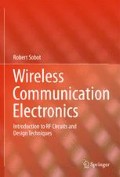Abstract
The main purpose of an electronic circuit is to process an electronic signal that has arrived at its input terminals. In other words, an abstract mathematical operation that was envisioned during the initial phases of the design is materialized in the form of a physical electronic circuit and its transfer function. The circuit is then expected to modify (i.e., to process) the input signal in accordance with the intended mathematical function and to pass the result to the next stage. In addition, a real, well-designed system should perform the signal-processing operations efficiently with minimal waste of time and energy. Hence, a number of interesting questions arise: What is the most optimal strategy for the energy transfer and signal processing? How should the interface between two subsequent stages be modelled and designed? Is it more beneficial to pass the signal from one stage to another in the form of voltage or in the form of current? Based on what criteria should the decision be made? What happens if it is not possible to achieve the optimal goal and what kind of compromises are appropriate to make? How should we deal with general, more complicated networks? In this chapter, we study a simple basic methodology for interfacing two stages in the signal processing chain that is commonly used in the design of RF electronic systems, with the main criterion being maximum power transfer between the stages. This approach is justified by the argument that wireless RF signals that have arrived at the system input terminals are very weak, thus subsequent power loss would have broad consequences for the overall system performance.
Access this chapter
Tax calculation will be finalised at checkout
Purchases are for personal use only
Notes
- 1.
In order to better visualize the design steps, the lower of the two resistances is labelled R − while the higher of the two is labelled R + .
- 2.
We use the same notation: \({R}_{-} = min[{R}_{0},{R}_{\mathrm{L}}]\) and \({R}_{+} = max[{R}_{0},{R}_{\mathrm{L}}]\).
Author information
Authors and Affiliations
Rights and permissions
Copyright information
© 2012 Springer Science+Business Media, LLC
About this chapter
Cite this chapter
Sobot, R. (2012). Matching Networks. In: Wireless Communication Electronics. Springer, Boston, MA. https://doi.org/10.1007/978-1-4614-1117-8_6
Download citation
DOI: https://doi.org/10.1007/978-1-4614-1117-8_6
Published:
Publisher Name: Springer, Boston, MA
Print ISBN: 978-1-4614-1116-1
Online ISBN: 978-1-4614-1117-8
eBook Packages: EngineeringEngineering (R0)

